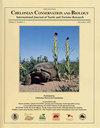如何最好地保护濒危Loggerhead Turtle Caretta Caretta的巢穴免受监控蜥蜴的捕食
IF 0.8
4区 生物学
Q3 ZOOLOGY
引用次数: 12
摘要
摘要在一项针对野生狐狸的控制计划启动后,巨蜥Varanus panoptes已成为昆士兰东南部深水国家公园附近Wreck Rock海滩海龟巢穴中最常见的捕食者。我们在两个筑巢季节(2014-2015年和2015-2016年)实证测试了铝网笼、塑料网片、红旗和辣椒粉在保护红海龟巢穴免受巨蜥捕食方面的效果。我们的研究表明,如果使用得当,塑料网是一种相对便宜且有效的方法,可以防止在海龟筑巢的海滩上捕食巨蜥巢穴。本文章由计算机程序翻译,如有差异,请以英文原文为准。
How Best to Protect the Nests of the Endangered Loggerhead Turtle Caretta caretta from Monitor Lizard Predation
Abstract After a control program for feral foxes was instigated, the monitor lizard Varanus panoptes has become the most common predator of loggerhead turtle nests at the Wreck Rock beach nesting aggregation adjacent to Deepwater National Park in southeastern Queensland. We empirically tested the efficacy of aluminum mesh cages, plastic mesh sheets, red flags, and hot chili powder in protecting loggerhead turtle nests from monitor lizard predation across 2 nesting seasons (2014–2015 and 2015–2016). Our study indicated that plastic mesh, when applied correctly, is a relatively inexpensive and effective way to prevent monitor lizard nest predation at sea turtle nesting beaches.
求助全文
通过发布文献求助,成功后即可免费获取论文全文。
去求助
来源期刊
CiteScore
1.70
自引率
14.30%
发文量
17
审稿时长
>12 weeks
期刊介绍:
Chelonian Conservation and Biology is a biannual peer-reviewed journal of cosmopolitan and broad-based coverage of all aspects of conservation and biology of all chelonians, including freshwater turtles, marine turtles, and tortoises. Manuscripts may cover any aspects of turtle and tortoise research, with a preference for conservation or biology. Manuscripts dealing with conservation biology, systematic relationships, chelonian diversity, geographic distribution, natural history, ecology, reproduction, morphology and natural variation, population status, husbandry, community conservation initiatives, and human exploitation or conservation management issues are of special interest.

 求助内容:
求助内容: 应助结果提醒方式:
应助结果提醒方式:


